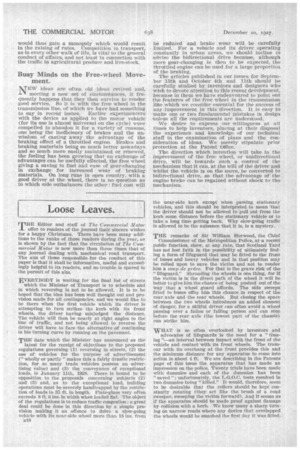Busy Minds on the Free-wheel Movement.
Page 36

If you've noticed an error in this article please click here to report it so we can fix it.
NEW ideas are often, old • ideas revived and, meeting a new set of circumstances, it frequently happens that they then survive to render good service. So it is with the free wheel in the transmission line, of which we have had something to say in recebt issues. Earlier experimenters with the device as applied to the motor vehicle (for its use is almost universal on the cycle) were compelled to abandon it for a variety of reasons, one being the inefficiency of brakes and the unwisdom of casting away the advantage of the braking effect of a throttled engine. Brakes and braking materials being so .much better nowadays and so much more easily maintained or renewed, the feeling has been growing that an exchange of advantages can be usefully effected, the free wheel giving a saving in fuel and ease of gear-changing in exchange for increased wear of braking materials. On long runs in open country, with a good driver at the wheel, there is no question as to .which side outbalances the other : fuel cost will
be reduced and brake wear will be carefully limited. For -a vehicle and its driver operating constantly in urban areas, we should incline to advise the bidirectional drive because, although more gear-changing IS then to be expected, the throttled engine can be used for a large proportion of the braking. The articles published in our issues for September 13th and October 4th and 11th should be carefully studied by inventors and designers who wish to devote attention to this recent development, because in them we have endeavoured to point out the features of the free wheel in the transmission litewhich we consider essential for the success of any iraprOvement in this direction. It is easy to make one or two fundamental Mistakes in design unless all the requirements are understood. We desire to express our willingness at all times to help inventors, placing at their disposal the experience and knowledge of our technical staff in the examination of plans and the consideration of ideas. We merely stipulate prior protection at the Patent Office.
The direction which invention will take in the improvement of the free svheel, or unidirectional drive, Will be towards sitar a control of the mechanism that it can, at the will of the driver and whilst the vehicle is on the move, be converted to bidirectional drive, so that the advantage of the. engine brake can be regained-without shock to the mechanism.




































































































